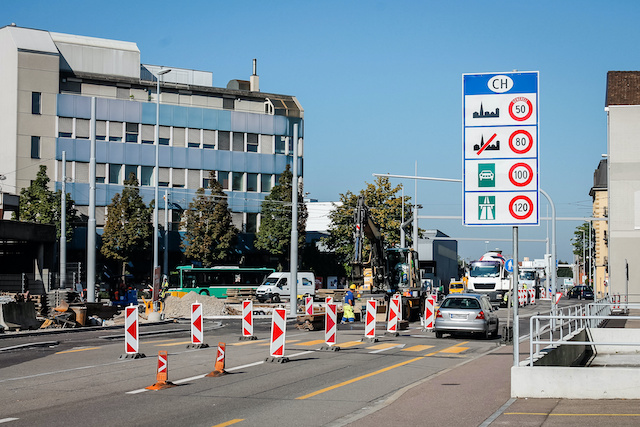Guide to Driving in Switzerland

Widely regarded as being one of the most scenic countries in Europe, Switzerland is a beautiful country to drive in. It is, however, not without its differences when compared to driving in the UK.
In this article, we look at everything you need to know when driving in Switzerland.
The Basics of Driving in Switzerland
As with the rest of mainland Europe, you must drive on the right-hand side of the road and overtake on the left. This also means that roundabouts flow the opposite way to roundabouts in the UK. Switzerland was one of the first countries to make it mandatory for drivers to have their lights on at all times, even during the day.
Essential Items
Before we go any further, we should start with a list of the required essentials that you will need when driving in Switzerland:
- Your current UK driving licence and insurance certificate
- Snow chains (especially if you are driving between November and March)
- A warning triangle
- Headlight converter stickers
- A GB sticker and a motorway sticker (Motorway Vignette)
If you are renting a car in Switzerland many of the items listed above will often come with the car as standard (for example, warning triangle, motorway vignette sticker and snow chains). However, the responsibility is with the driver to ensure that they meet these minimum requirements.
What is the Swiss Motorway Vignette Sticker?
If you intend on using the motorway in Switzerland, it is compulsory to have a motorway vignette sticker. Drivers can purchase vignettes at the Swiss border or online and costs CHF40 (approximately £32). Even if you are not planning on using the motorway, we recommend that you purchase one just in case. The fine for not having a motorway sticker is CHF200 (around £156) plus the cost of a sticker. If you are hiring a car in Switzerland, it is highly likely that it will come with a vignette sticker.
Paperwork Requirements for Driving in Switzerland If you are driving your own car, it is essential to make sure that your insurance covers you for driving in Switzerland. Like in the UK, third party insurance is the minimum level of insurance and you must have cover before travelling. You should also have a printed copy of your insurance certificate and your UK driving licence in the car.
Winter Driving in Switzerland
Amongst the many things that Switzerland is famous for are mountains and picturesque winter scenes. These can be beautiful to look at, but they also make for challenging driving conditions if you are not prepared. Most major roads will have warning signs (“Ketten obligatorisch” meaning Chains obligatory), advising drivers when to attach snow chains.
On alpine roads it is compulsory to carry snow chains, even in 4 wheel drive vehicles. If you are involved in an accident in icy conditions without snow chains, insurance may not cover you. Although seen as a suitable and easier alternative to snow chains in the UK, snow socks are not legal in Switzerland.
Speed Limits
Speed limits are heavily enforced in Switzerland, not only for the safety of road users and pedestrians but also to limit pollution. Even driving 1kph over the limit can incur a fine of CHF40. Driving more than 16kmh over the limit in a built-up area can result in a court summons.
The driving speed limits in Switzerland are very similar to those of the UK. They are as follows:
- 50kph (31 mph) in built-up urban areas
- 80kph (49.7 mph) on open roads
- 120kph (74.5 mph) on motorways.
It is important to note that it is illegal to use any piece of equipment that alerts the driver of speed cameras. This is a standard feature of many sat navs, although many models have the option to turn off radar detection.
Driving in Rural Switzerland
Around 80% of the country can be described as being of rural character, so it is highly likely that you will drive near wildlife on your journey. On small country roads, be prepared to slow down or stop for farm vehicles and/or cows, goats and sheep. Any accidents involving wildlife must be reported to the police. On narrow, hilly roads, ascending traffic has priority. This means that if you are driving downhill, you should prepare to give way to vehicles coming towards you.
Getting to Switzerland
Although this guide is primarily on driving in Switzerland, it is important to keep in mind the requirements of driving in any other countries that you may drive through on your journey. For example, it is not a legal requirement to have reflective jackets in the car in Switzerland.
However, you will be legally required to have one for each person in the car while driving through France, as well as an alcohol breathalyser. You should also keep in mind that it is illegal to use a bluetooth hands free kit in France.
Other useful things to remember
- In an emergency, you can dial 112 in any European country and be transferred to the local emergency services
- Although carrying a first aid kit, fire extinguisher and a set of spare bulbs is not a legal requirement, they are recommended
- Police can give on-the-spot fines for any motoring offence
Driving in Switzerland, or any foreign country, can seem a little daunting at first. It is important to remain calm while driving and avoid drink-driving or driving while tired in order to remain focussed. A lot of the road signs and speed limits in Switzerland are very similar to the ones in use in the UK, and most of Europe. Once you get used to driving on the right you should feel at ease.
If you are considering moving to Zurich, Basel, Geneva, Bern or anywhere else in this beautiful country, click here to find out more about Cadogan Tate’s specialist moving to Switzerland service.



